Preparation and Optimization of Modified Asphalt by Profile Control Parameters at Lamadian Oilfield
Abstract
:1. Introduction
2. Experimental Program
2.1. Experimental Materials
2.2. Sulfonation Modification of Asphalt Particles
2.3. Matching Relationship between Asphalt Particle Size and Concentration and Formation
2.4. Optimization of Asphalt Particle Profile Control Radius
3. Results and Discussions
3.1. Basic Properties of Modified Asphalt Binder
3.1.1. Suspension Rate Detection
3.1.2. Bonding Temperature Detection
3.1.3. Research on the Dispersion Effect of Asphalt Binder
3.2. Injectability of Asphalt Binder and Its Matching Relationship with Formation of Porous Media
3.3. Optimization of Concentration and Profile Control Radius of Asphalt Particle Profile Control Agent System
4. Summary and Conclusions
Author Contributions
Funding
Data Availability Statement
Conflicts of Interest
References
- Wei, J.; Zhao, X.; Liu, X.Z.X.; Zhang, H.; Jamshid, O.I.J. Methodology for Estimating Strength and Elasticity of Granular Profile Control Agents Used in ASP water Flooding. Chem. Technol. Fuels Oils 2020, 55, 790–799. [Google Scholar]
- Zhao, X.; Fu, M.; Wang, Z.; Dong, L.; Tang, J. Research overview of profile control and water shut-off agents for heavy oil thermal recovery. Spec. Oil Gas Reserv. 2011, 20, 1–4. [Google Scholar]
- Cao, G.; Cheng, Q.; Liu, Y.; Bu, R.; Zhang, N.; Wang, P. Influencing Factors of Surfactant Stripping Crude Oil and Spontaneous Imbibition Mechanism of Surfactants in a Tight Reservoir. ACS Omega 2022, 7, 19010–19020. [Google Scholar] [CrossRef]
- Pu, W.; Wen, C.; Liu, R.; Jin, F.; Wang, C.; Liao, Z. Evaluation of a novel profile control agent for enhancing an oil-recovery application. J. Appl. Polym. Sci. 2016, 133, 43756. [Google Scholar] [CrossRef]
- Dong, L.; Wang, M.; He, J.; Ding, M.; Lin, H. Experimental Investigation of Self-Assembled binder on Profile Control in the Fuyu Oilfield. Front. Chem. 2021, 9, 681846. [Google Scholar] [CrossRef] [PubMed]
- Chen, X.; Li, Y.; Liu, Z.; Zhang, J.; Chen, C.; Ma, M. Investigation on matching relationship and plugging mechanism of self-adaptive micro-gel (SMG) as a profile control and oil displacement agent. Powder Technol. 2020, 5, 774–784. [Google Scholar] [CrossRef]
- Nascimento, D.R.; Oliveira, B.R.; Saide, V.G.P.; Magalhaes, S.C.; Scheid, C.M.; Calcada, L.A. Effects of particle-size distribution and solid additives in the apparent viscosity of drilling fluids. J. Pet. Sci. Eng. 2019, 182, 106275. [Google Scholar] [CrossRef]
- Zhang, L.; Zhuang, W.; Nasir, K.; Zheng, L. Effect of stress relaxation and creep recovery on transportation in porous medium and fracture of the millimeter-scale polymer gel binder for conformance control of heterogeneous oil reservoir. J. Pet. Sci. Eng. 2020, 185, 106648. [Google Scholar] [CrossRef]
- Ren, C.; Li, J.; Li, Y.; Yuan, J.; Xi, Y.; Xiao, K.; Wang, Y. Experimental Investigation of the Matching Relationship between Asphalt Particle and Reservoir Pore in Profile Control Process. J. Eng. 2016, 2016, 2507316. [Google Scholar] [CrossRef]
- Li, Y.; Xiang, G.; Wang, Y.; Li, Y.Y.; Li, J.J. Matching of asphalt binder and formation pores for conformance control treatment in Lamadian Oilfield of Daqing. J. China Univ. Pet. 2015, 39, 92–96. [Google Scholar]
- Liu, G.; Jiang, H.; Li, J.; Wang, M.; Chen, F.; Ding, S.; Lu, X. Evaluation of the performance of polymer gels mixed with asphalt particle as a novel composite profile control system. Energy Weekly News 2015, 7, 309–314. [Google Scholar] [CrossRef]
- Du, D.; Pu, W.; Tan, X.; Liu, R. Experimental study of secondary crosslinking core-shell hyperbranched associative polymer gel and its profile control performance in low-temperature fractured conglomerate reservoir. J. Pet. Sci. Eng. 2019, 6, 912–920. [Google Scholar] [CrossRef]
- Kabir, A.H.; Petronas Carigali Sdn Bhd. Chemical water & gas shut off technology—An overview. In Proceedings of the SPE Asia Pacific Improved Oil Recovery Conference, Kuala Lumpur, Malaysia, 8–9 October 2001. [Google Scholar]
- Wu, D.; Zhou, K.; Zhaon, F.; Lu, X.; An, Z.; Liu, S.; Hou, J. Determination of Permeability Contrast Limits for Applying Polymer Solutions and Viscoelastic Particle Suspensions in Heterogeneous Reservoirs. Energy Fuels 2022, 7, 7495–7506. [Google Scholar] [CrossRef]
- Shao, M.; Fu, L.; Yue, X. Experimental Study on Aggregation Regulation and Plugging Performance of Nanobinder in Low-permeability Heterogeneous Cores. Chemistryselect 2022, 7, e202104085. [Google Scholar] [CrossRef]
- Yu, H.; Gao, M.; Du, C.; Zhang, M. Preparation and properties of flexible particle profile control agent based on waste rubber. Appl. Chem. Ind. 2021, 50, 2985–2988. [Google Scholar]
- Yang, C. Development and Application of Profile Control and Oil Displacement Agent Contained Oil Sludge Filled Gel Particle. Oilfield Chem. 2018, 35, 422–426. [Google Scholar]
- Wang, C.; Zhang, L.; Ju, G.; Sun, Q. Development and Performance Evaluation of a High-Temperature Profile Control System. ACS Omega 2020, 5, 17828–17838. [Google Scholar] [CrossRef]
- Chen, Y.; Wang, K.; Li, G.; Lu, C. Plugging mechanism of large size profile control binder and deep migration performance. Lithol. Reserv. 2019, 31, 159–164. [Google Scholar]
- Tan, L.; Chang, L.; Shen, J.; Liu, Y.; Yang, Z.; Liu, C. Evaluation and field application of intercalative gel binder as deep profile control agent. Chem. Eng. Oil Gas 2019, 48, 78–80. [Google Scholar]
- Mu, Y.; Wang, B.; Sun, Z. Preparation and study of waste drilling fluid profile control water plugging agent. Reserv. Eval. Dev. 2019, 9, 68–71. [Google Scholar]
- Sun, X.; Sun, X.; Xu, Z.; Zhao, S.; Xu, C. PGSS method for preparation of deoiled asphalt particles. J. Chem. Eng. Coll. Univ. 2010, 2, 290–295. [Google Scholar]

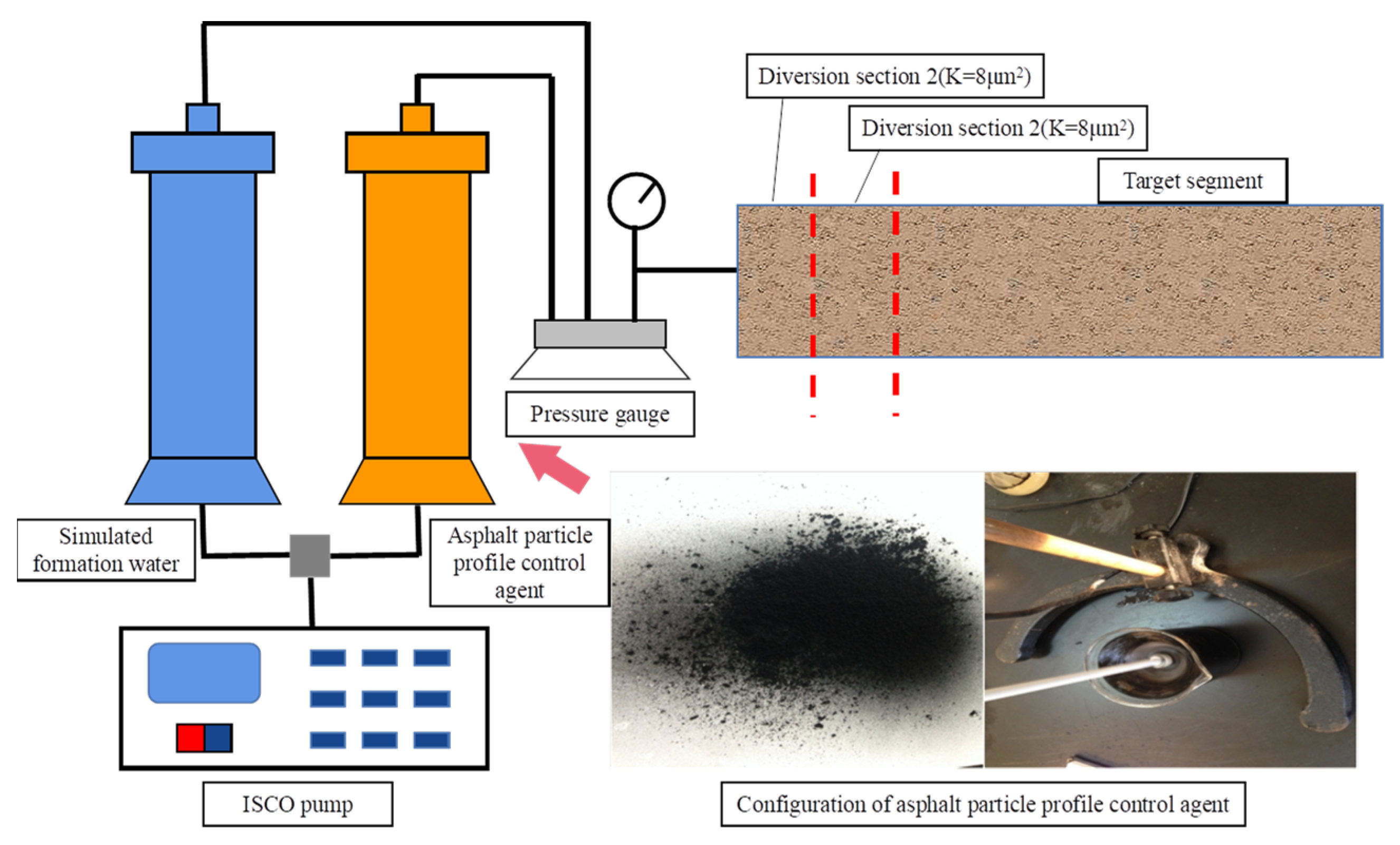
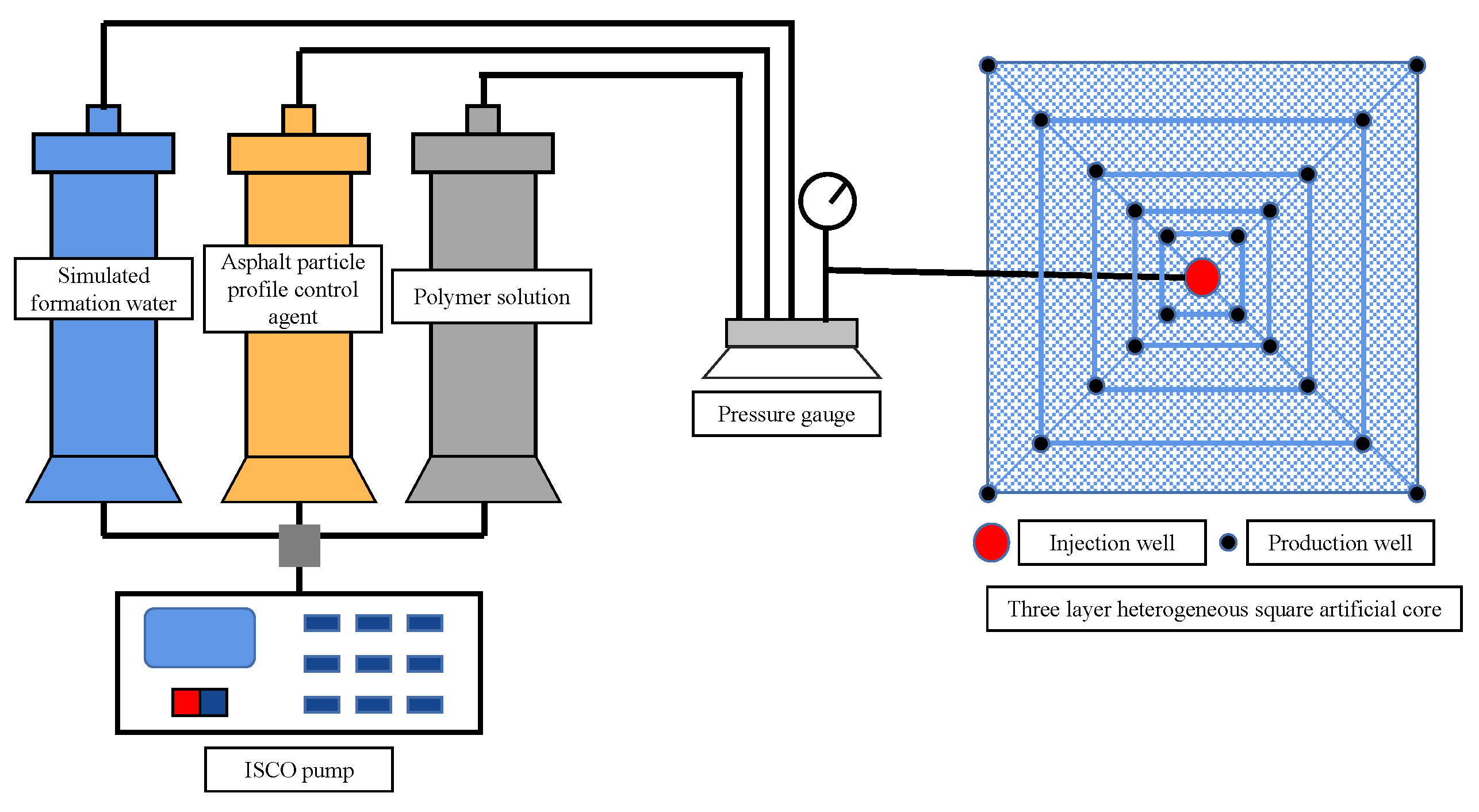
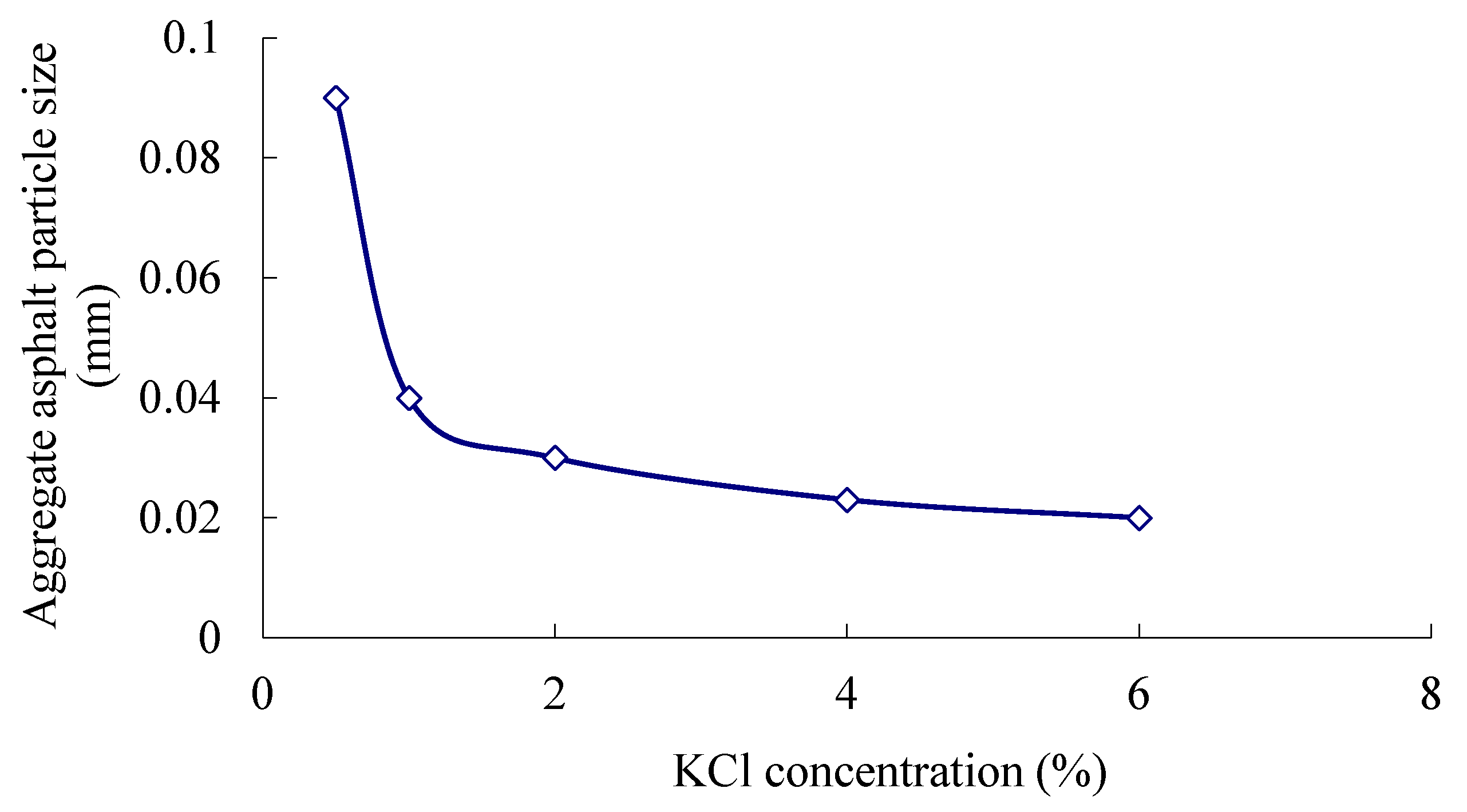
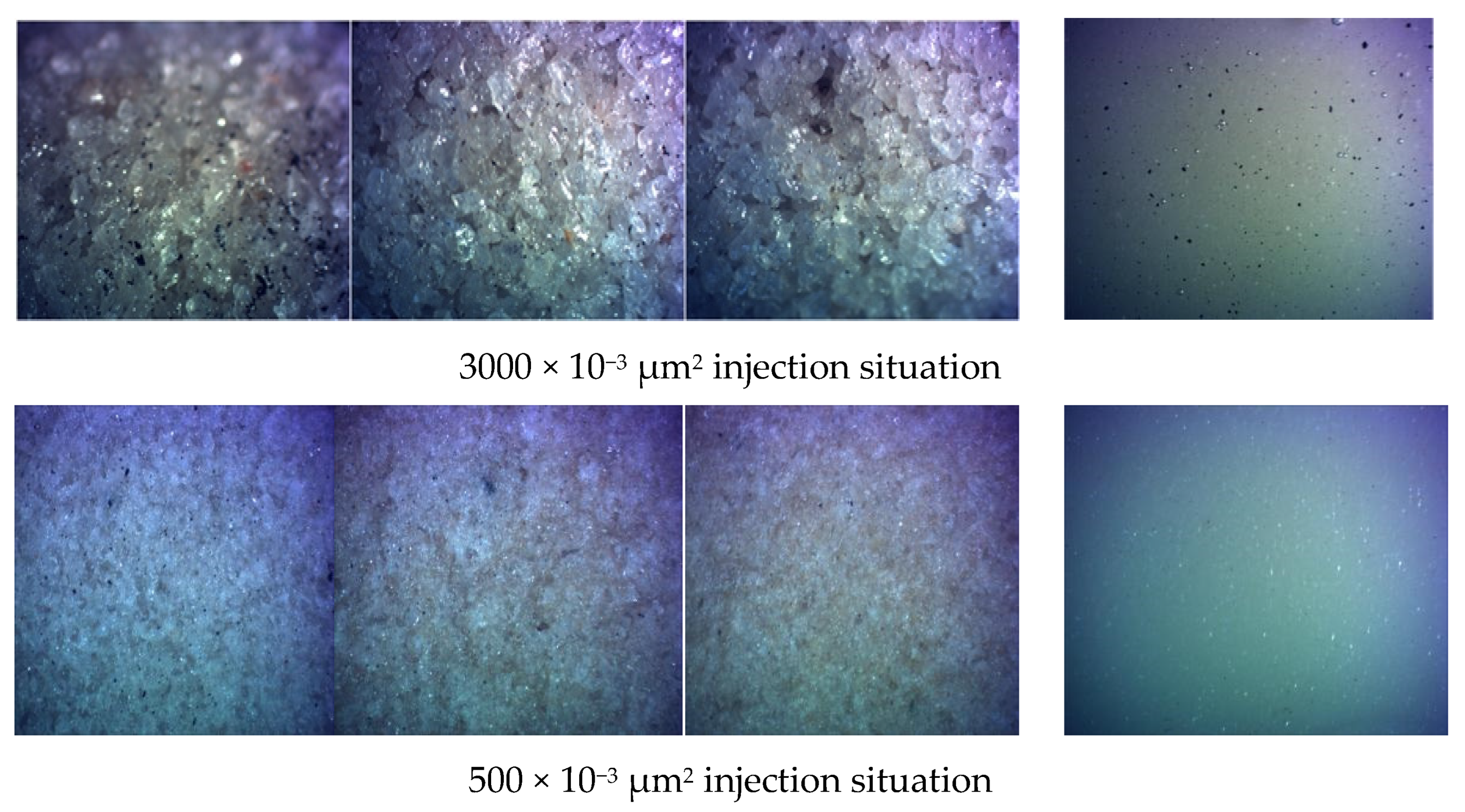
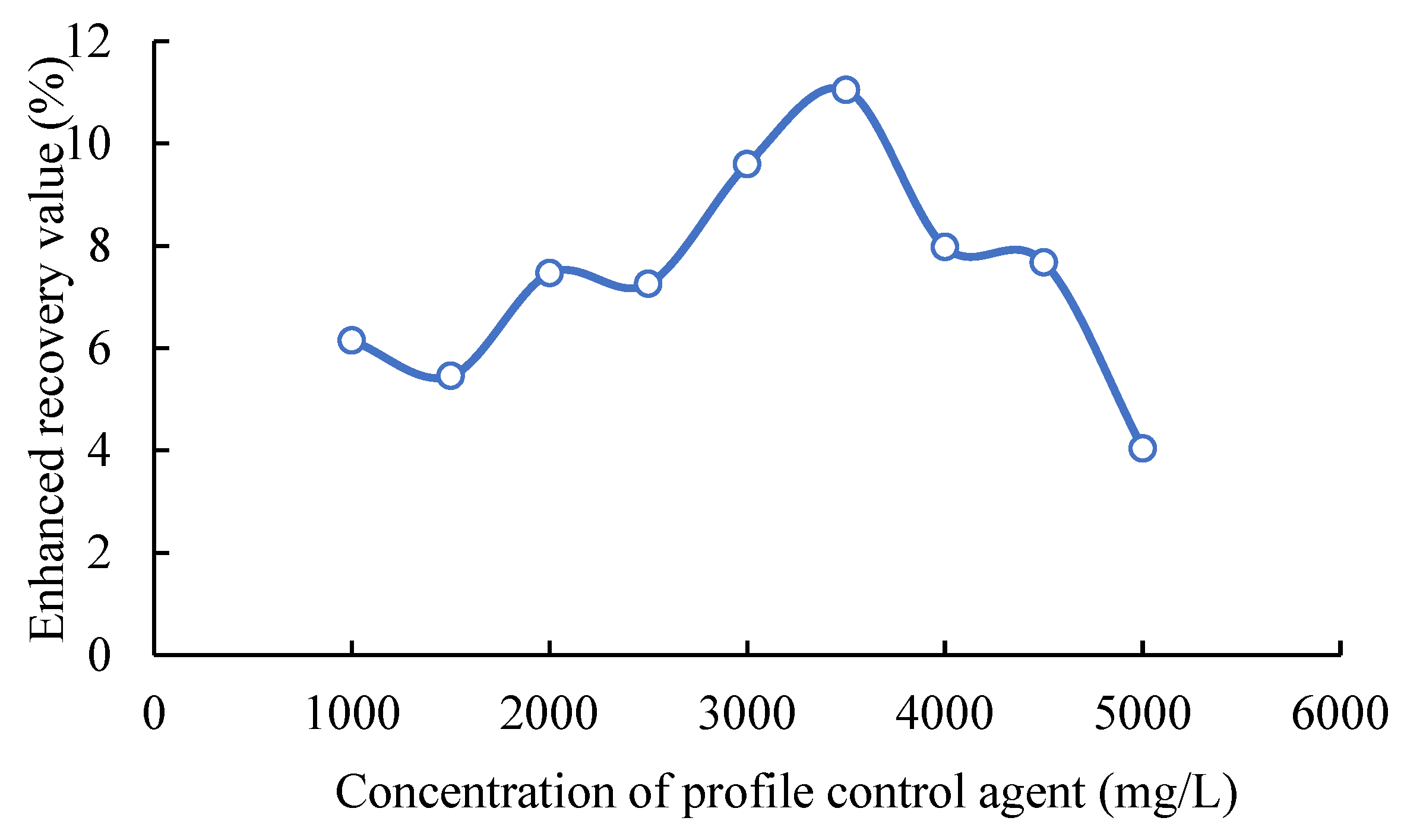

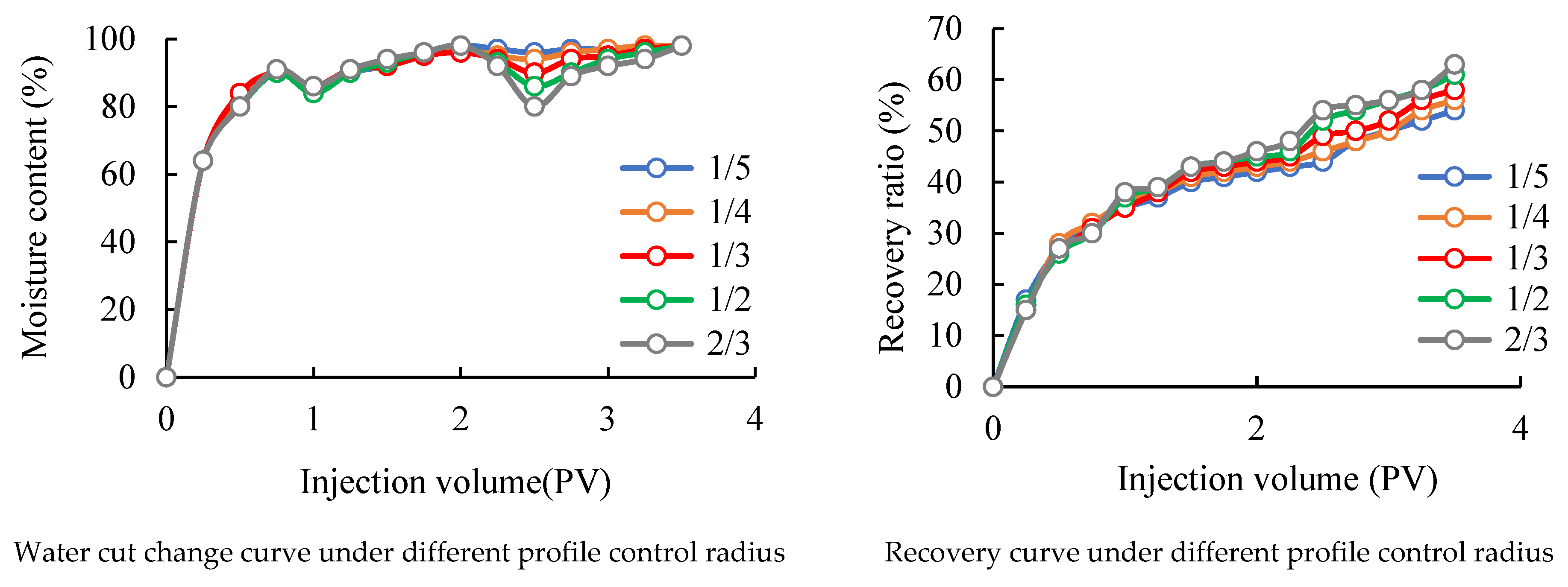
| Component | HCO3− | CO32− | Cl− | SO42− | Ca2+ | Mg2+ | Na+ | Total Salinity |
|---|---|---|---|---|---|---|---|---|
| Concentration (mg/L) | 2400 | 213 | 2453 | 65 | 23 | 12 | 3000 | 8167 |
| Particle Size (mm) | Addition Amount (g) | Residue Weight (g) | Suspension Rate (%) |
|---|---|---|---|
| 0–0.02 | 5 | 0.192 | 96.16% |
| 0.02–0.06 | 5 | 0.315 | 93.70% |
| 0.06–0.1 | 5 | 0.35 | 93.00% |
| 0.1–0.3 | 5 | 0.398 | 92.04% |
| 0.3–0.8 | 5 | 0.495 | 90.10% |
| Permeability (×10−3 μm2) | Particle Size (mm) | Kwb (×10−3 μm2) | Kwa (×10−3 μm2) | Resistance Coefficient | Residual Resistance Coefficient | Plugging Rate | Enhanced Recovery (%) |
|---|---|---|---|---|---|---|---|
| 500 | 0.02 | 515 | 155 | 26.48 | 3.26 | 0.71 | 12.52 |
| 528 | 169 | 25.15 | 3.13 | 0.67 | 11.69 | ||
| 0.02 | 515 | 145 | 28.50 | 3.55 | 0.74 | 12.87 | |
| 505 | 140 | 29.60 | 3.63 | 0.75 | 13.05 | ||
| 1500 | 0.02 | 1505 | 783 | 15.59 | 1.90 | 0.47 | 11.35 |
| 1503 | 812 | 14.98 | 1.86 | 0.45 | 10.99 | ||
| 0.02–0.06 | 1515 | 685 | 18.02 | 2.24 | 0.56 | 14.70 | |
| 1505 | 657 | 18.63 | 2.31 | 0.58 | 15.96 | ||
| 0.06–0.1 | 1497 | 662 | 18.37 | 2.25 | 0.55 | 16.69 | |
| 1510 | 670 | 18.17 | 2.28 | 0.58 | 16.25 | ||
| 3000 | 0.02 | 3010 | 1385 | 17.55 | 2.15 | 0.55 | 9.92 |
| 2995 | 1410 | 17.25 | 2.17 | 0.50 | 9.72 | ||
| 0.02–0.06 | 3045 | 1250 | 19.50 | 2.43 | 0.60 | 10.95 | |
| 2990 | 1270 | 19.10 | 2.35 | 0.59 | 10.05 | ||
| 0.06–0.1 | 3010 | 1105 | 22.10 | 2.75 | 0.65 | 11.00 | |
| 3020 | 1096 | 22.35 | 2.75 | 0.67 | 11.93 | ||
| 0.1–0.3 | 2990 | 995 | 24.42 | 3.05 | 0.64 | 11.33 | |
| 3022 | 985 | 24.80 | 3.05 | 0.65 | 11.76 |
| Penetration (×10−3 μm2) | Injectable Particle Size (mm) | Non-Injectable Particle Size (mm) |
|---|---|---|
| 500 | 0.02, 0.02–0.06 | 0.06–0.1, 0.1–0.3, 0.3–0.8 |
| 1500 | 0.02, 0.02–0.06, 0.06–0.1 | 0.1–0.3, 0.3–0.8 |
| 3000 | 0.02, 0.02–0.06, 0.06–0.1, 0.1–0.3 | 0.3–0.8 |
| Injection Radius | Injection Volume (mL) | Waterflood Recovery (%) | Polymer Flooding Recovery (%) | Ultimate Recovery (%) | Recovery Increase (%) |
|---|---|---|---|---|---|
| 1/5 | 184.10 | 35.16 | 44.36 | 54.16 | 9.80 |
| 1/4 | 305.20 | 36.69 | 45.72 | 55.98 | 10.26 |
| 1/3 | 528.85 | 35.07 | 47.36 | 57.95 | 10.59 |
| 1/2 | 1215.20 | 36.72 | 49.14 | 61.25 | 12.11 |
| 2/3 | 1699.95 | 37.03 | 50.26 | 63.15 | 12.89 |
Publisher’s Note: MDPI stays neutral with regard to jurisdictional claims in published maps and institutional affiliations. |
© 2022 by the authors. Licensee MDPI, Basel, Switzerland. This article is an open access article distributed under the terms and conditions of the Creative Commons Attribution (CC BY) license (https://creativecommons.org/licenses/by/4.0/).
Share and Cite
Luo, Q.; Li, K.; Shan, G.; Cao, G.; Bai, Y.; Zhang, N.; Wu, J. Preparation and Optimization of Modified Asphalt by Profile Control Parameters at Lamadian Oilfield. Processes 2022, 10, 1917. https://doi.org/10.3390/pr10101917
Luo Q, Li K, Shan G, Cao G, Bai Y, Zhang N, Wu J. Preparation and Optimization of Modified Asphalt by Profile Control Parameters at Lamadian Oilfield. Processes. 2022; 10(10):1917. https://doi.org/10.3390/pr10101917
Chicago/Turabian StyleLuo, Qing, Kemin Li, Gaojun Shan, Guangsheng Cao, Yujie Bai, Ning Zhang, and Jiajun Wu. 2022. "Preparation and Optimization of Modified Asphalt by Profile Control Parameters at Lamadian Oilfield" Processes 10, no. 10: 1917. https://doi.org/10.3390/pr10101917
APA StyleLuo, Q., Li, K., Shan, G., Cao, G., Bai, Y., Zhang, N., & Wu, J. (2022). Preparation and Optimization of Modified Asphalt by Profile Control Parameters at Lamadian Oilfield. Processes, 10(10), 1917. https://doi.org/10.3390/pr10101917








